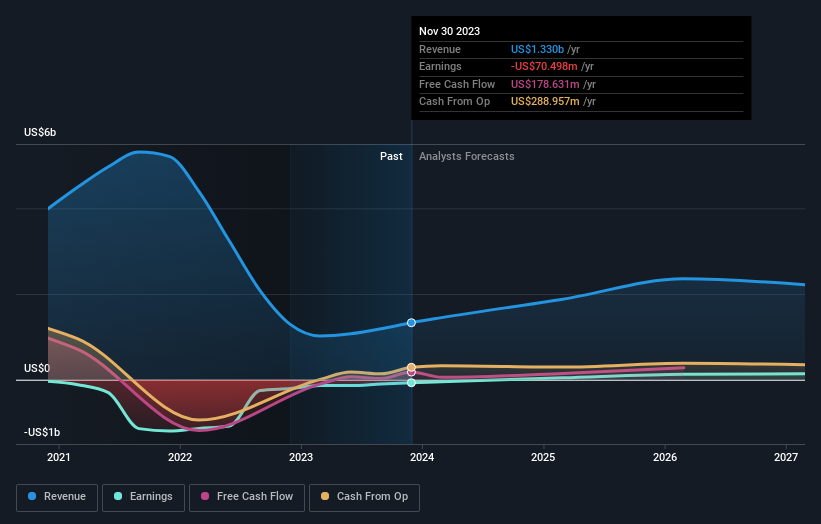- United States
- /
- Consumer Services
- /
- NYSE:TAL
Institutional investors may overlook TAL Education Group's (NYSE:TAL) recent US$798m market cap drop as long-term gains remain positive

Key Insights
- Significantly high institutional ownership implies TAL Education Group's stock price is sensitive to their trading actions
- 51% of the business is held by the top 12 shareholders
- Insider ownership in TAL Education Group is 31%
To get a sense of who is truly in control of TAL Education Group (NYSE:TAL), it is important to understand the ownership structure of the business. With 39% stake, institutions possess the maximum shares in the company. That is, the group stands to benefit the most if the stock rises (or lose the most if there is a downturn).
Losing money on investments is something no shareholder enjoys, least of all institutional investors who saw their holdings value drop by 9.7% last week. However, the 98% one-year return to shareholders might have softened the blow. But they would probably be wary of future losses.
Let's take a closer look to see what the different types of shareholders can tell us about TAL Education Group.
Check out our latest analysis for TAL Education Group

What Does The Institutional Ownership Tell Us About TAL Education Group?
Institutional investors commonly compare their own returns to the returns of a commonly followed index. So they generally do consider buying larger companies that are included in the relevant benchmark index.
We can see that TAL Education Group does have institutional investors; and they hold a good portion of the company's stock. This suggests some credibility amongst professional investors. But we can't rely on that fact alone since institutions make bad investments sometimes, just like everyone does. If multiple institutions change their view on a stock at the same time, you could see the share price drop fast. It's therefore worth looking at TAL Education Group's earnings history below. Of course, the future is what really matters.

TAL Education Group is not owned by hedge funds. With a 27% stake, CEO Bangxin Zhang is the largest shareholder. For context, the second largest shareholder holds about 4.2% of the shares outstanding, followed by an ownership of 3.0% by the third-largest shareholder. Interestingly, the second-largest shareholder, Yachao Liu is also Chief Operating Officer, again, pointing towards strong insider ownership amongst the company's top shareholders.
A closer look at our ownership figures suggests that the top 12 shareholders have a combined ownership of 51% implying that no single shareholder has a majority.
While it makes sense to study institutional ownership data for a company, it also makes sense to study analyst sentiments to know which way the wind is blowing. There are plenty of analysts covering the stock, so it might be worth seeing what they are forecasting, too.
Insider Ownership Of TAL Education Group
The definition of an insider can differ slightly between different countries, but members of the board of directors always count. Management ultimately answers to the board. However, it is not uncommon for managers to be executive board members, especially if they are a founder or the CEO.
I generally consider insider ownership to be a good thing. However, on some occasions it makes it more difficult for other shareholders to hold the board accountable for decisions.
Our information suggests that insiders maintain a significant holding in TAL Education Group. Insiders own US$2.3b worth of shares in the US$7.4b company. That's quite meaningful. It is good to see this level of investment. You can check here to see if those insiders have been buying recently.
General Public Ownership
The general public, who are usually individual investors, hold a 30% stake in TAL Education Group. This size of ownership, while considerable, may not be enough to change company policy if the decision is not in sync with other large shareholders.
Next Steps:
While it is well worth considering the different groups that own a company, there are other factors that are even more important.
I like to dive deeper into how a company has performed in the past. You can access this interactive graph of past earnings, revenue and cash flow, for free.
If you would prefer discover what analysts are predicting in terms of future growth, do not miss this free report on analyst forecasts.
NB: Figures in this article are calculated using data from the last twelve months, which refer to the 12-month period ending on the last date of the month the financial statement is dated. This may not be consistent with full year annual report figures.
Valuation is complex, but we're here to simplify it.
Discover if TAL Education Group might be undervalued or overvalued with our detailed analysis, featuring fair value estimates, potential risks, dividends, insider trades, and its financial condition.
Access Free AnalysisHave feedback on this article? Concerned about the content? Get in touch with us directly. Alternatively, email editorial-team (at) simplywallst.com.
This article by Simply Wall St is general in nature. We provide commentary based on historical data and analyst forecasts only using an unbiased methodology and our articles are not intended to be financial advice. It does not constitute a recommendation to buy or sell any stock, and does not take account of your objectives, or your financial situation. We aim to bring you long-term focused analysis driven by fundamental data. Note that our analysis may not factor in the latest price-sensitive company announcements or qualitative material. Simply Wall St has no position in any stocks mentioned.
About NYSE:TAL
TAL Education Group
Provides K-12 after-school tutoring services in the People’s Republic of China.
High growth potential with adequate balance sheet.

